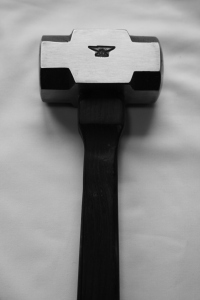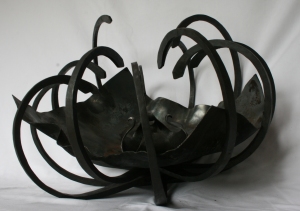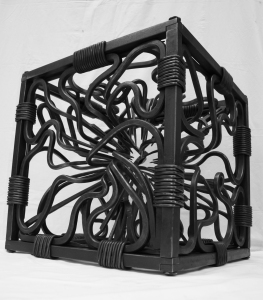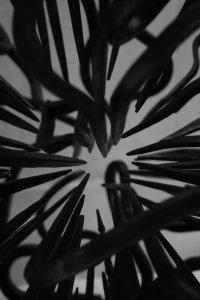Last year I was asked by a client how I approach my work, and unusually for me, I didn’t have an answer. So, I’ve been examining just how I do approach it and these are the answers I’ve discovered for myself.
Firstly, I tend to divide my work up into different categories with different slants for each. Pure functional (Tools and such items), Commissioned functional, Commissioned Sculpture and Personal Sculpture.
Pure Functional:
With tools and other pure functional work, form must follow function. There is no point making a tool that does not perform. While to some this might seem to be a limitation on creativity, I have found it very liberating. Having set rules to work within can help to focus you mind, which frees you up in so many ways. This has become so true to me that I often use tool making as a way loosen up or clear my mind in-between other projects.

As you can see with this 3lb rounding hammer I made, there is still plenty of scope to create sculptural forms. In fact I often feel that tools are the purest form of sculpture. Just look at the stone axes of early human endeavour. Those tools were, in my eyes, our first ventures into the sculptural world.
Commissioned Functional:
Here there are several things at play, all vying for attention. You have, as with the tools, a function that must be respected. Your client, who is paying you, wants the piece to work for them in a set way. If it’s a gate, for instance, it must span the gap, it must open. These are a given. Then, you are responding to the environment which also leads you to your client. They have put this space together so it is a good indicator as to their own vision. I want this type of work to work for my clients. Mostly, I find people approach me because of my portfolio so they are already open to my style of work, I don’t tend to get many conflicts here. Then I have my own reaction to the space. Usually when I see a space, I want to fill it. (Don’t know what that says about me. No puns intended). The combination of all these things helps to form my approach, not necessarily meaning the creation of something that will blend in with its surroundings. If I feel the space needs something that will create contrast, that is what I will design and I have occasionally turned work away as I felt the customer was asking for something that would not work in the space.
Above all I want to produce work I’m happy with, otherwise I might as well work for someone else and not have the headaches that go hand-in-hand with having you own art practice. I love this type of work because you are developing a relationship between yourself, the client and the space. It can lead you into unexpected areas and push you in ways other types of work don’t. Also it is a great moment when your client sees the work for the first time and you have exceeded their expectations.
Commissioned Sculpture:
Mostly this for me has meant public pieces of sculpture. Here you are responding to a particular brief and, surprisingly, it can be where you find yourself being asked to compromise your work the most. I try to find an area of the brief that interests me and focus on that; if the brief is really uninteresting there is very little point in getting involved in the project. I get a lot of my inspiration from a deep-set belief in my work and if I don’t believe in the project I won’t produce the work to do it justice. Obviously as with commissioned functional work, I am also responding to the environment in which the piece will be set. I want above all to create a conversation between the brief, the environment and the work, getting a good feel for the space is crucial. The biggest difference in my approach to this type of work is I have to fully design it on paper. This is something to which I’m a little resistant. My medium is hot forged steel, mostly, and drawing my work out has always felt like I am working to another medium. Now I know it has huge advantages, and working in this way has pushed me and my work which is a very good thing. But I still have to be dragged to the drawing table every time.
Personal Sculpture:
What I define as personal sculpture is work that I’m only creating to satisfy my own feelings and needs without a view to the reaction it will provoke in others. My first approach here is where I have a fully conceptualised idea in my head. I don’t sketch it and I don’t change it. It tends to just flow out of me in a frenzy of compulsive forging. Sometimes I will see something in the making of the piece and will have to decide whether to adapt the piece or store the idea for future work but on the whole I’m trying to bring my vision of the piece into fruition in its entirety as I conceptualised it as with this sculpture: A war crime by any other name.

I also have this method where I have a concept which in itself is fully formed in such a way that I have a framework and maybe a series of way points and a loose idea of how to hit those points. This sculpture, The gift that keeps on oppressing, illustrates my point.

I knew I wanted a cube frame for it and a void at its centre that was under stress. But I didn’t know exactly what that would look like. So I created the frame and made the first inset spike, then each subsequent inset responded to the pieces before. This also helped me overcome one of the other problems I foresaw, which was how to create a randomness to the spikes at the same time as framing the void. Sometimes with this type of approach it can feel like the sculpture is working you rather than the other way around. This can feel a little unnerving, even terrifying, and can be almost all consuming at times. At the end of making this piece I felt exhausted and drained, so much so my wife called it “the black hole” for the two months I worked on it.
The thing that stays constant throughout these differing approaches is the pure joy it is to light a fire and manipulate hot steel. You can’t beat it! (Pun intended)



well said, cheers
i enjoyed that insight into your work, eye opening
Thanks Alex. Sorry for the late reply.